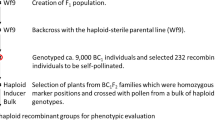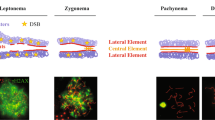Abstract
Microsporogenesis of several Brachiaria species of the Brazilian collection at Embrapa Beef Cattle has been analyzed in detail. This paper reports abnormal cytokinesis in three accessions of three different species (Brachiaria humidicola, 2n = 4x = 36, Brachiaria decumbens, 2n = 4x = 36, and Brachiaria dura, 2n = 6x = 54). Chromosomes paired in bi-, tri-, and quadrivalents in these accessions, whereas chromosome segregation at meiosis I was characterized by exclusion of laggards as micronuclei. In a high number of meiocytes, the first sign of cytokinesis appeared only in metaphase II and did not divide the meiocyte into a dyad. Total absence of cytokinesis was also detected among meiocytes in the second division. Since in both cases the two metaphase plates were very close, they favored the rejoining of chromosome sets after anaphase II and formed a restitutional nucleus in telophase II. Second cytokinesis occurred after telophase II in most meiocytes. Monads, dyads, and triads with n or 2n nuclei were observed among meiotic products. The 2n gametes observed correspond to the first division restitution (FDR). The number of affected cells in each accession was variable, but the number of microspores with restitutional nucleus, including those scored in tetrads and the released ones, did not exceed 9%. Although polyploidy is common in the genus Brachiaria, its origin is still unclear. Current results suggest that 2n gametes may have contributed to the evolutionary history of the genus.

Similar content being viewed by others
References
Barba-Gonzalez R, Lokker AC, Lim KB, Ramanna MS, Tuyl JM (2004) Use of 2n gametes for the production of sexual polyploids from sterile Oriental x Asiatic hybrids of lilies (Lilium). Theor Appl Genet 109:1125–1132
Bennett MD (2004) Perspectives on polyploidy in plants—ancient and neo. Biol J Linn Soc 82:411–423
Bretagnolle F, Thompson JD (1995) Gametes with the somatic chromosome number: mechanisms of their formation and role in the evolution of autopolyploid plants. New Phytol 129:1–22
Carputo D, Barone A, Frusciante L (2000) 2n gametes in the potato: essential ingredients for breeding and germplasm transfer. Theor Appl Genet 101:805–813
Ferris C, Callow RS, Gray AJ (1992) Mixed first and second division restitution in male meiosis of Hierochloë odorata (L.) Beauv (Holy grass). Heredity 69:21–31
Harlan JR, De Wet JMJ (1975) On Ö Winge and a prayer: the origins of polyploidy. Bot Rev 41:361–390
Lim KB, Ramanna MS, Jong JH, Jacobsen E, Tuyl JM (2001) Indeterminate meiotic restitution (IMR): a novel type of meiotic nuclear restitution detected in interspecific lily hybrids by GISH. Theor Appl Genet 103:219–230
Mariani A, Tavoletti S (1992) Alfalfa evolution and breeding through 2n gametes. In: Veronesi F et al (eds) Gametes with somatic chromosome number in the evolution and breeding of polyploidy polysomic species: achievements and perspectives. Proceedings workshop, Tipografia Forziuncula, Assisi, Italy, pp 73–81
Mendes-Vieira D, Boldrini KR, Mendes-Bonato AB, Pagliarini MS, Valle CB (2006) Cytological evidence of natural hybridization in Brachiaria brizantha Stapf (Gramineae). Bot J Linn Soc 150:441–446
Mendes-Bonato AB, Pagliarini MS, Forli F, Valle CB, Penteado MIO (2002) Chromosome number and microsporogenesis in Brachiaria brizantha (Gramineae). Euphytica 125:419–425
Mendes-Bonato AB, Pagliarini MS, Risso-Pascotto C, Valle CB (2006) Chromosome number and meiotic behavior in Brachiaria jubata (Gramineae). J Genet 85:83–87
Miles JW, Maass BL, Valle CB (1996) Brachiaria: biology, agronomy, and improvement. CIAT/Embrapa, Colombia, 288 p
Miles JW, Valle CB, Rao IM, Euclides VPB (2004) Brachiaria-grasses. In: Sollenberger L (ed) Warm-Season (C4) grasses. Agronomy Monograph, no. 45. ASA, CSSA, SSSA, Madison, pp 745–760
Osborn TC (2004) The contribution of polyploidy to variation in Brassica species. Physiol Plantarum 121:531–536
Pagliarini MS, Takayama SY, Freitas PM, Carraro LR, Adamowski EV, Silva N (1999) Failure of cytokinesis and 2n gamete formation in Brazilian accessions of Paspalum. Euphytica 108:129–135
Pannell JR, Obbard DJ, Buggs RJA (2004) Polyploidy and the sexual system: what can we learn from Mercurialis annua?. Biol J Linn Soc 82:547–560
Penteado MIO, Santos ACM, Rodrigues IF, Valle CB, Seixas MAC, Esteves A (2000) Determinação de poliploidia e avaliação da quantidade de DNA total em diferentes espécies de gênero Brachiaria. Boletim de Pesquisa, 11. Campo Grande-MS, Embrapa Gado de Corte, Embrapa, Ministério da Agricultura, 32 p
Ramanna MS (1979) A re-examination of the mechanisms of 2n gametes formation in potato and its implications for breeding. Euphytica 28:537–561
Risso-Pascotto C, Pagliarini MS, Valle CB, Mendes-Bonato AB (2003) Chromosome number and microsporogenesis in pentaploid accession of Brachiaria brizantha (Gramineae). Plant Breed 122:136–140
Utsunomiya KS, Pagliarini MS, Valle CB (2005) Microsporogenesis in tetraploid accessions of Brachiaria nigropedata (Ficalho & Hiern) Stapf (Gramineae). Biocell 29:295–301
Valle CB, Savidan YH (1996) Genetics, cytogenetics, and reproductive biology of Brachiaria. In: Miles JW, Maass BL, Valle CB (eds) Brachiaria: biology, agronomy, and improvement. CIAT/Embrapa, Colombia, pp 147–163
Veilleux R (1985) Diploid and polyploid gametes in crop plants: mechanisms of formation and utilization in plant breeding. Plant Breed Rev 3:253–288
Author information
Authors and Affiliations
Corresponding author
Rights and permissions
About this article
Cite this article
Gallo, P.H., Micheletti, P.L., Boldrini, K.R. et al. 2n Gamete formation in the genus Brachiaria (Poaceae: Paniceae). Euphytica 154, 255–260 (2007). https://doi.org/10.1007/s10681-006-9294-1
Received:
Accepted:
Published:
Issue Date:
DOI: https://doi.org/10.1007/s10681-006-9294-1




